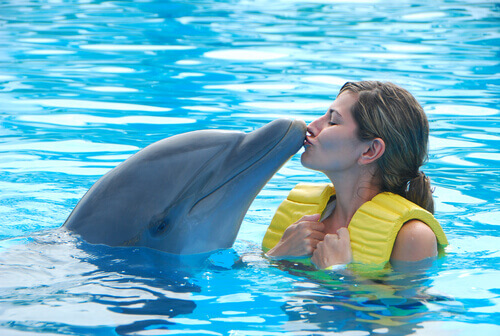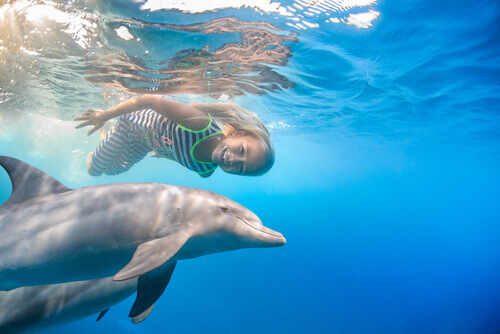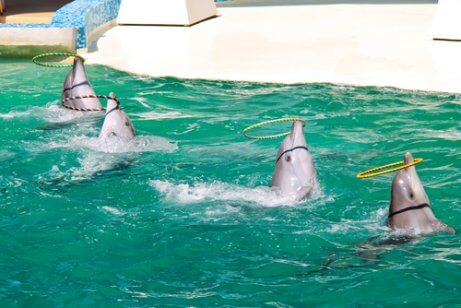Do Dolphins in Captivity Suffer?

There’s a great debate surrounding raising dolphins in captivity in order to provide entertainment for humans. They also participate in the rehabilitation and stimulation of children and adults with disabilities. But the question remains, do dolphins in captivity suffer because of their lack of freedom?
Dolphins around the world
Experts currently estimate that there are more than 2,000 cetaceans living in captivity in aquariums in 60 countries. Although most of them are dolphins and whales, we can also find porpoises and belugas.
The first dolphinarium opened in Florida during the 30s. From there, shows involving cetaceans became increasingly popular and the number of aquariums multiplied.
The top countries in the world for dolphinariums are Japan, China, the USA, Mexico, Russia, Ukraine, and Spain. Spain has 12, which is the highest concentration of dolphins in captivity in Europe.
Presently, despite scientific evidence that dolphins in captivity do indeed suffer, dolphinariums continue to be a lucrative business. In fact, the commercial breeding of dolphins is considered an industry on its own in Russia, Japan, China, and Mexico.

The false image of dolphins in captivity
The film and TV industry have successfully created a fantasy image of dolphins within people’s minds, particularly within the minds of children. What child wouldn’t be touched by the charismatic dolphin Flipper, for example? From a young age, we learn to associate a dolphin’s expressions with happiness.
However, many dolphins in captivity actually display a number of signs of stress, anxiety, and depression. The fact that they don’t show this when they’re performing doesn’t mean that they don’t feel negative emotions.
In reality, dolphins are extremely intelligent and sensitive creatures that mainly communicate through gestures and sounds. It’s uncommon for a dolphin to use facial expressions to communicate their thoughts, feelings, or emotions. So, we naturally assume that because a dolphin seems to be constantly smiling, they’re always happy.
How dolphins are captured
Very few people ask themselves how a dolphin gets to be in an aquarium in the first place. Almost all cetaceans in captivity have been captured in their natural habitat and violently stripped of their freedom. Dolphins born in captivity are very uncommon.
Capture is an aggressive process that is highly stressful for the animal and could put their life at risk. Basically, a number of boats chase and harass them with the aim of cornering them somewhere. Often, small explosives are used to scare them and force them to move.
In some countries, such as the USA or Mexico, the capture of cetaceans is banned by law. However, this hasn’t put an end to this practice, and it certainly doesn’t mean that the dolphins you see in an aquarium weren’t captured in the wild.

Since the mortality rate for dolphins is relatively high, their capture in the wild continues. Many are currently captured off the coasts of Cuba, Japan, Russia, China, Indonesia, and large parts of Africa.
How dolphins in captivity suffer
Obviously, once in captivity, these animals live a completely artificial life. A dolphin that once swam freely in the ocean now needs to adapt to small tanks that contain chemically-treated water. As well as become more sedentary, these dolphins also tend to develop allergies and inflammations because of the chlorine and the pH levels in the water.
Furthermore, dolphins in captivity are constantly overstimulated. During their ‘shows’ and training, they have to bear loud music, shouting, horns, and other noise. All of this is extremely stressful for them.
Other harmful factors for them are the lack of shade and the shallowness of their pools. Their skin and mucosas are very sensitive, so exposure to solar radiation can be very dangerous. It’s very common to find dolphins in captivity with sunburn.
Last but not least, the environments they live in are extremely bare and lacking in enrichment. Cetaceans are curious and intelligent animals, and they need to be mentally stimulated to stay healthy and happy.
In their natural habitat, these animals can explore. D olphins in captivity, on the other hand, live a monotonous existence. This can lead to a number of physical and mental illnesses.
https://myanimals.com/es/delfines-en-cautividad-realmente-sufren/
